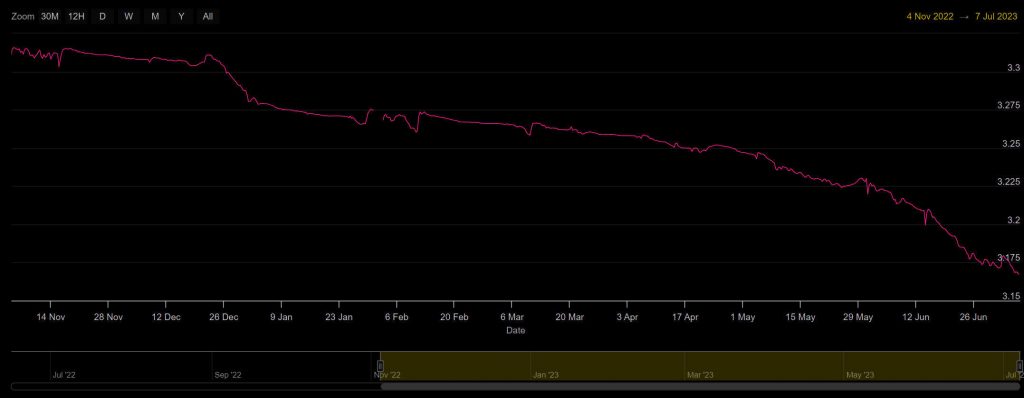A while back, after using my Nordic PPK2 Power Profiler to gather power-usage data for the floater, I did some basic calculations to try and determine the theoretical battery lifespan.
The test has been running for many months and finished on 31st Dec 2022.
With the floater sending data every 5-min, my theoretical lifespan was 8 and-a-bit months.
What was actually achieved was 7 months, 3 weeks, 5 days.
Considering the events over the testing time, I’m pretty happy about the end result.
It is a sample-size of one so not necessarily typical. It is what it is.
In that time I had WiFi dropouts, power-cuts, my Raspberry-pi that logs the data locked-up for over a week before I noticed, and the home router died and was replaced.
The Raspberry-pi lockup did not affect the battery lifespan but the other stuff did so there was several periods of WiFi logon-timeouts for the floater. Considering all that, just under 8 months was a good result.
Device cut-off was 2.9V. Looking at the graph, its definitely over the edge of the discharge cliff so perhaps 3V would be better.
The shape of the discharge was unexpected. I have no explanation of the dip and recovery about 2/3 of the way through the test. There were no WiFi issues around that time.
As the final steep decline starts, the router started to have issues and the ‘lift’ of the voltage was after a series of high-discharge events (WiFi timeouts).
I’m speculating if the higher-than-normal discharges have an effect on the battery chemistry (the mobility of charge transfer).
The normal discharging current pulses are short and infrequent. Maybe the higher (and more sustained) current pulses help things to move around more at a molecular level.
Or I could be completely barking up the wrong tree and its a software glitch in my sampling/averaging routine. The reported voltage is the average of a run of 64 samples.
The step-down a bit later is when the router died so a bunch of WiFi timeouts for the floater, till the replacement router was fitted. This happened after the knee of rapid voltage drop.
If anyone reading this knows more about the low level battery chemistry of LiFePo4 cells and how they behave, I’d be happy to hear from them 🙂

7-July-23
And another one..
This floater is inside a metal brewery keg, which is in a modified fridge (for temperature control). It uses a small repeater sitting on top of the keg because the loss going from inside two metal containers (keg + fridge) is too much, but from just inside the fridge is OK. The fridge is not so RF ‘sealed’ so easy to get the signal out.
This has run for 8-months so far (4-Nov-22 to 7-Jul-23) and is down to ~3.16 volts so probably time to recharge as its just at the start of the final faster decline.
The WiFi environment was mostly good but the router was unplugged for an afternoon. All in all, a quite reasonable result.
I don’t apply any temperature compensation to the ADC readings and this shows up as the sudden dips/peaks as the temperature swings by 20-degC (or more) during a cold-crash.
The floater reporting rate was set to 5-min.

